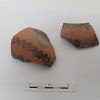
| Culture | Branch | Tradition | Ware | Type |
| Ancestral Pueblo: Southern Colorado Plateau (Anasazi) | Central Anasazi | Northern San Juan | Northern San Juan Red Ware | Bluff Black-on-red |
Type Name: Bluff Black-on-red |
|
| Period: | 780 A.D. - 940 A.D. |
| Culture: | Ancestral Pueblo: Southern Colorado Plateau (Anasazi) |
| Branch: | Central Anasazi |
| Tradition: | Northern San Juan |
| Ware: | Northern San Juan Red Ware |
First posted by C. Dean Wilson 2012
Bluff Black on red was first described by Hargrave (1936). This type developed out of Abajo Red on orange and appears to have been first produced at about A.D. 780. The transition was complete by A.D. 820, and the type continued to be produced until at least A.D. 940 and perhaps as late as A.D. 1000 (Blinman 1988).
The paste characteristics of Bluff Black on red are similar to those noted for Abajo Red on orange, including the occasional presence of a washy slip. Early examples of Bluff Black on red share design elements and layouts with Abajo Red on orange, and the principal distinction between the two types is paint color (Breternitz and others 1974: Lucius and Breternitz 1981; Martin 1936; Oppelt 1992; Wilson and Blinman 1995). The range of vessel forms (bowls, seed jars, and pitchers) is similar for the two types. Although early design elements of Bluff Black-on-red are identical to those of Abajo Red on orange, there is a temporal trend toward increasingly fine line-work and toward reliance on design elements other than straight and wavy lines. On the late end of the Bluff Black on-red range, there is considerable overlap with design elements used in Deadman’s Black on red. These are largely distinguished by slip characteristics.
An additional difference between Bluff Black on red and both Abajo Red-on-orange and Deadman’s Black-on-red is that a minority of late (post-A.D. 880) Bluff Black on red vessels were produced with crushed sherd temper and a pinkish paste resulting in their classifications as Bluff Black on red, McPhee variety (Wilson and Ericson 1985). The McPhee variety reflects a brief and short experimentation with sherd temper not related to the use of this temper later Tsegi Orange Ware types.
References:
Blinman, Eric
1988 The Interpretation of Ceramic Variability: A Case Study from the Dolores Anasazi. Ph.D. dissertation, Department of Anthropology, Washington State University, Pullman.
Breternitz, David A., Arthur H. Rohn, Jr., and Elizabeth A. Morris
1974 Prehistoric Ceramics of the Mesa Verde Region. 2nd ed. Museum of Northern Arizona Ceramic Series 5, Flagstaff.
Hargrave, L. Lyndon
1936 Notes on a Red Ware from Bluff, Utah. Southwestern Lore, 2(2):29-34.
Lucius, William A., and David Breternitz
1981 The Current Status of Red Wares in the Mesa Verde Region. In Collected Papers in Honor of Erick Kellerman Reed, edited by A. H. Schroeder, pp. 99-111. Archaeological Society of New Mexico 6, Albuquerque.
Martin, Paul S.
1936 Lowry Ruin in Southwestern Colorado. Field Museum of Natural History Anthropological Series 23 (1). Field Museum of Natural History, Chicago.
Oppelt, Norman T.
1992 Earth Water Fire: The Prehistoric Pottery of Mesa Verde. Johnson Books, Boulder.
Wilson, C. Dean, and Mary P. Errickson
1985 Formal Description of Bluff Black on red, McPhee Variety. Pottery Southwest 12(1):2-4.
Wilson, C. Dean, and Eric Blinman
1995 Ceramic Types of the Mesa Verde Region. In Archaeological Pottery of Colorado: Ceramic Clues to the Prehistoric and Protohistoric Lives of the State's Native Peoples, edited by R.H. Brunswig, B. Bradley, and S.M. Chandler, pp. 33-88. Colorado Council of Archaeologists Occasional Papers 2, Denver.
Related Photos
 © New Mexico Office of Archaeological Studies, a division of the New Mexico Department of Cultural Affairs.
© New Mexico Office of Archaeological Studies, a division of the New Mexico Department of Cultural Affairs.
The Center for New Mexico Archaeology
7 Old Cochiti Road
Santa Fe, NM 87507
505-476-4404
Fax: 505-476-4448







